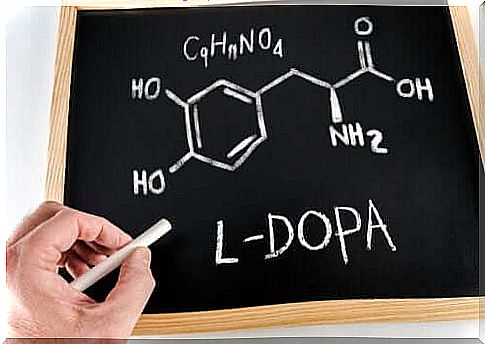Levodopa: What Is It For?
Levodopa is a drug which belongs to the therapeutic family of anti-parkinsonian drugs. It is a drug which has an action on the central nervous system, and is transformed into dopamine in the brain.

The Levodopa is the fundamental therapy for Parkinson’s disease. It combines with other dopa decarboxylase inhibitor drugs, such as cabidopa or benserazide, to treat this disease.
On the other hand, levodopa is a drug which belongs to the therapeutic family of anti-parkinsonian drugs. It acts on the central nervous system by transforming into dopamine in the brain.
The first person to associate Parkinson’s disease with dopamine deficiency was biochemist Oleh Hornykiewicz. He looked at the autopsies of patients with Parkinson’s and suggested this relationship. Then this scientist started treating patients with a racemic mixture of DOPA, with positive results.
Shortly after, another scientist, Curt Porter, demonstrated that the L-DOPA stereoisomer was actually active, which reduced the effective dose of the component by half.
Subsequently, various molecules began to be synthesized, such as for example benserazide or carbodopa. This improved the results of the treatment. Besides, this also led to a further reduction in the dose needed to achieve the same effects.
Know certain aspects of Parkinson’s disease

Parkinson’s is a disease of the central nervous system caused by a deficiency of the neurotransmitter dopamine in striated neurons, due to the death of nigro-striatal neurons.
The origin of this disease is multifactorial. In addition, it has a rather high prevalence among the general population. The most affected population group are the elderly. More specifically, this disease affects 2% of people aged 65 years. However, it can also manifest in young people.
Parkinson’s presents a very common symptom which is the onset of tremors. The latter affects more than 60% of patients. However, other motor symptoms can also appear:
- Rigidity
- Slow movements, also known as bradykinesia
- Alterations in postural reflexes and falls
Other symptoms that can occur with the course of this disease are:
- Dementia and memory loss
- Hallucinations
- Depression
- Dysphagia
- Muscle pain
- Neuropathic pain
Furthermore, it is known that this disease is linked to an increase in the alpha-synuclein protein. The latter is also associated with Alzheimer’s. This is why the therapeutic strategy under study consists of administering inhibitors of alpha-synuclein aggregation or of immunizing. There is a study done with Nilotinib that tries to study this type of therapy.
General characteristics of levodopa
The therapy for Parkinson’s disease involves trying to increase dopamine levels by working directly on the receptors. This is possible by inhibiting the breakdown of the neurotransmitter or by inhibiting LAAD. The enzyme that turns dopa into dopamine.
In this sense, one may wonder why dopamine is not directly administered to the patient. The problem is, it exhibits high reuptake as well as high metabolism. This prevents the absorption of dopamine. In addition, dopamine is a very soluble molecule in water. It is therefore unable to cross the blood-brain barrier, which protects the brain.
For all these reasons, Parkinson’s disease is treated with the dopamine precursor, levodopa. This substance manages to cross the blood-brain barrier and turns into dopamine once it reaches the central and peripheral nervous system.
However, levodopa, although it can cross this barrier, has a potent metabolism at the peripheral level. The amount that reaches the brain is therefore very small.
To solve this problem, it is taken with other drugs that inhibit the LAAD enzyme, as we have mentioned. Indeed, it slows down the transformation of levodopa into dopamine at the peripheral level. And, ultimately, more levodopa gets to the brain.
Benefits of administering levodopa in combination with LAAD inhibitors

Co-administration of this type of medicine reduces the amount of levodopa to be given by 75%. This is because it increases the shelf life of the drug. And helps keep the levels more stable in the brain.
Thanks to this, the clinical efficacy is greater and the action is therefore faster. By reducing the amount of dopamine in peripheral tissues, the cardiovascular and gastrointestinal consequences are also reduced. In short, levodopa is always combined with benserazide or with cabidopa.
Conclusion…
Levodopa is the first line of treatment to fight Parkinson’s disease. This medication is administered with others to increase its effectiveness.
Finally, you can consult the doctor or pharmacist if you have the slightest doubt about this disease and its treatment. As well as to inform you about the progress and clinical trials in progress.









